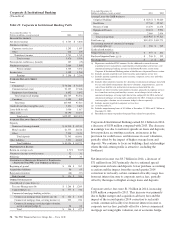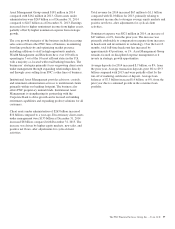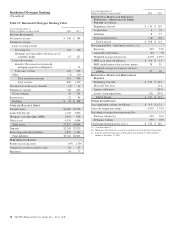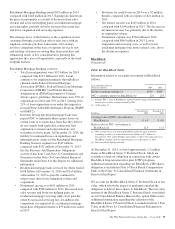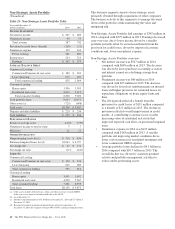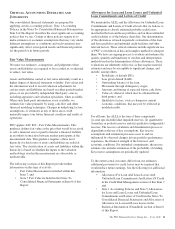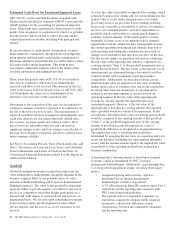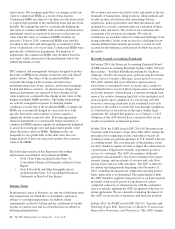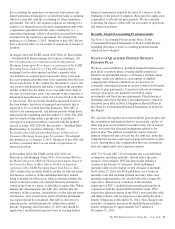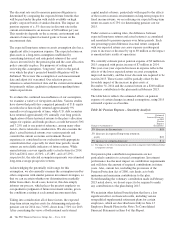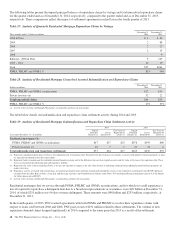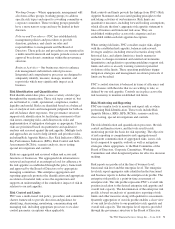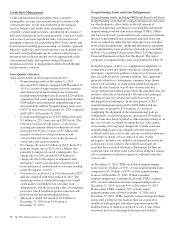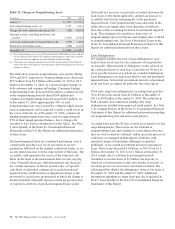PNC Bank 2014 Annual Report Download - page 82
Download and view the complete annual report
Please find page 82 of the 2014 PNC Bank annual report below. You can navigate through the pages in the report by either clicking on the pages listed below, or by using the keyword search tool below to find specific information within the annual report.
expectations. We recognize gain/(loss) on changes in the fair
value of commercial MSRs as a result of that election.
Commercial MSRs are subject to declines in value from actual
or expected prepayment of the underlying loans and also from
defaults. We manage this risk by economically hedging the
fair value of commercial MSRs with securities and derivatives
instruments which are expected to increase (or decrease) in
value when the value of commercial MSRs declines (or
increases). Prior to 2014, commercial MSRs were initially
recorded at fair value and subsequently accounted for at the
lower of amortized cost or fair value. Commercial MSRs were
periodically evaluated for impairment. For purposes of
impairment, the commercial MSRs were stratified based on
asset type, which characterizes the predominant risk of the
underlying financial asset.
PNC employs risk management strategies designed to protect
the value of MSRs from changes in interest rates and related
market factors. The values of the residential MSRs are
economically hedged with securities and derivatives,
including interest-rate swaps, options, and forward mortgage-
backed and futures contracts. As interest rates change, these
financial instruments are expected to have changes in fair
value negatively correlated to the change in fair value of the
hedged residential MSRs portfolio. The hedge relationships
are actively managed in response to changing market
conditions over the life of the residential MSRs. Commercial
MSRs are economically hedged at a macro level or with
specific derivatives and securities to protect against a
significant decline in interest rates. Selecting appropriate
financial instruments to economically hedge residential or
commercial MSRs requires significant management judgment
to assess how mortgage rates and prepayment speeds could
affect the future values of MSRs. Hedging results can
frequently be less predictable in the short term, but over
longer periods of time are expected to protect the economic
value of the MSRs.
The following sections of this Report provide further
information on residential and commercial MSRs:
• Note 7 Fair Value included in the Notes To
Consolidated Financial Statements in Item 8 of this
Report.
• Note 8 Goodwill and Other Intangible Assets
included in the Notes To Consolidated Financial
Statements in Item 8 of this Report.
Income Taxes
In the normal course of business, we and our subsidiaries enter
into transactions for which the tax treatment is unclear or
subject to varying interpretations. In addition, filing
requirements, methods of filing and the calculation of taxable
income in various state and local jurisdictions are subject to
differing interpretations.
We evaluate and assess the relative risks and merits of the tax
treatment of transactions, filing positions, filing methods and
taxable income calculations after considering statutes,
regulations, judicial precedent, and other information, and
maintain tax accruals consistent with our evaluation of these
relative risks and merits. The result of our evaluation and
assessment is by its nature an estimate. We and our
subsidiaries are routinely subject to audit and challenges from
taxing authorities. In the event we resolve a challenge for an
amount different than amounts previously accrued, we will
account for the difference in the period in which we resolve
the matter.
Recently Issued Accounting Standards
In January 2014, the Financial Accounting Standards Board
(FASB) issued Accounting Standards Update (ASU) 2014-04,
Receivables – Troubled Debt Restructurings by Creditors
(Subtopic 310-40): Reclassification of Residential Real Estate
Collateralized Consumer Mortgage Loans upon Foreclosure.
This ASU clarifies that an in substance repossession or
foreclosure is considered to have occurred, and a creditor is
considered to have received physical possession of residential
real estate property collateralizing a consumer mortgage loan,
upon a) the creditor obtaining legal title to the residential real
estate property upon completion of a foreclosure or b) the
borrower conveying all interest in the residential real estate
property to the creditor to satisfy the loan through completion
of a deed in lieu of foreclosure or through a similar legal
agreement. We adopted this guidance as of January 1, 2015.
Adoption of this ASU did not have a material effect on our
results of operations or financial position.
In May 2014, the FASB issued ASU 2014-09, Revenue from
Contracts with Customers (Topic 606). This ASU clarifies the
principles for recognizing revenue and replaces nearly all
existing revenue recognition guidance in U.S. GAAP with one
accounting model. The core principle of the guidance is that
an entity should recognize revenue to depict the satisfaction of
a performance obligation by transfer of promised goods or
services to customers. The ASU also requires additional
qualitative and quantitative disclosures relating to the nature,
amount, timing, and uncertainty of revenue and cash flows
arising from contracts with customers. The ASU is effective
for annual reporting periods beginning after December 15,
2016, including interim periods within that reporting period.
Early application is not permitted. The requirements within
the ASU should be applied retrospectively to each prior period
presented (with several practical expedients for certain
completed contracts) or retrospectively with the cumulative
effect of initially applying the ASU recognized at the date of
initial application. We are currently evaluating the impact of
this ASU on our results of operations and financial position.
In June 2014, the FASB issued ASU 2014-11, Transfers and
Servicing (Topic 860): Repurchase-to-Maturity Transactions,
Repurchase Financings, and Disclosures. This ASU changes
64 The PNC Financial Services Group, Inc. – Form 10-K


